IF I FORGET THEE, O JERUSALEM
Following the Destruction of the Beit Hamikdash, our Sages introduced a number of practices whose purpose is to remind us of Yerushalayim and the Beit Hamikdash. Our Sages felt that anything that brings joy should be accompanied by a zecher l’Churban, a remembrance of the Destruction, because without Yerushalayim and the Beit Hamikdash, there is no complete joy.
Thus the zecher l’Churban customs are designed to inspire feelings of mourning over the current exile. These practices include leaving a commemorative space in one’s home (an unfinished square on the wall); never setting an elaborate table (except for Shabbat and yom tov); reciting Psalm 137 (Al Naharot Bavel) before bentching on weekdays; breaking a plate at a tenayim; placing ashes on a groom’s forehead during the wedding ceremony; breaking the glass under a chuppah and banning live music at weddings which take place in Yerushalayim.
What are some of the basic halachot regarding leaving a commemorative space on one’s wall in one’s home?
1. The unfinished square should measure one amah by one amah (one cubit by one cubit). The unfinished square should be obvious when one enters the home; ideally, it should be on the wall opposite the door of the house. (Some have the custom of leaving a commemorative space above the door.) Others say the unfinished area can be made anywhere if it is larger than an amah by an amah. If one cannot make it on the wall opposite the entrance, one should make it as close to that wall as possible.
2. A shul, beit midrash and yeshivah do not require a zecher l’Churban.
3. The halachah of making a zecher l’Churban applies to Jews living throughout the world, including those living in Yerushalayim. It applies even if one can view the site of the Churban from one’s home.
It is unfortunate that the custom of leaving an unfinished square as a zecher l’Churban in one’s home is not commonly observed.
However, there are many who take the laws of zecher l’Churban seriously, and some have added creative and artistic elements to the commemorative spaces on their walls. Following are a few examples of interesting ways people have found to memorialize the Destruction of the Temple.
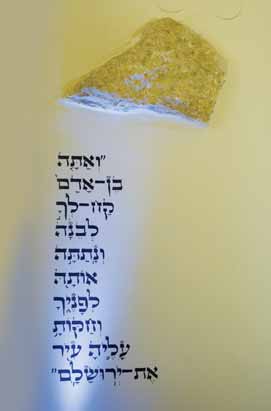 Michoel Raanan, a great-grandson of Rabbi Avraham Yitzchak HaCohen Kook, and his wife, Amira, have an unusual zecher l’Churban in their home in Rosh Tzurim in Gush Etzion. A piece of Jerusalem stone juts out from the wall and below it is a verse from Yechezkel 4:1: “Now you, son of man, take for yourself a brick, place it before you, and engrave on it a city—Jerusalem.”
Michoel Raanan, a great-grandson of Rabbi Avraham Yitzchak HaCohen Kook, and his wife, Amira, have an unusual zecher l’Churban in their home in Rosh Tzurim in Gush Etzion. A piece of Jerusalem stone juts out from the wall and below it is a verse from Yechezkel 4:1: “Now you, son of man, take for yourself a brick, place it before you, and engrave on it a city—Jerusalem.”
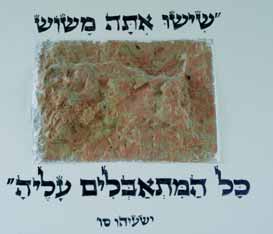 A few doors away from the Raanans is the Lifchitz family with this zecher l’Churban hanging on their wall.
A few doors away from the Raanans is the Lifchitz family with this zecher l’Churban hanging on their wall.
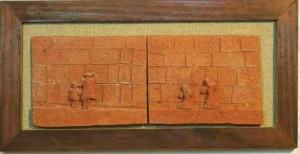 Our talented neighbor in Rosh Tzurim, Yisrael Snir, works with ceramics. Hanging on his wall is a ceramic Kotel with a women’s and men’s section. On the bottom of each section is a quote from Midrash Rabba: “The Divine Presence never moves from the Western Wall.”
Our talented neighbor in Rosh Tzurim, Yisrael Snir, works with ceramics. Hanging on his wall is a ceramic Kotel with a women’s and men’s section. On the bottom of each section is a quote from Midrash Rabba: “The Divine Presence never moves from the Western Wall.”
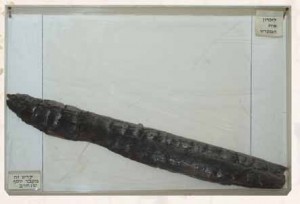 A very poignant zecher l’Churban is found in the home of Shaina and Shmuel Buchwald of Har Nof, Jerusalem. Encased in glass on the wall is a charred piece of wood taken from Kever Yosef after it was burned and desecrated by terrorists.
A very poignant zecher l’Churban is found in the home of Shaina and Shmuel Buchwald of Har Nof, Jerusalem. Encased in glass on the wall is a charred piece of wood taken from Kever Yosef after it was burned and desecrated by terrorists.
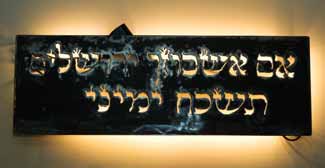 An illuminated iron plaque with the words “If I forget thee O Jerusalem . . .” serves as a zecher l’Churban for the Shendor family of Rosh Tzurim.
An illuminated iron plaque with the words “If I forget thee O Jerusalem . . .” serves as a zecher l’Churban for the Shendor family of Rosh Tzurim.
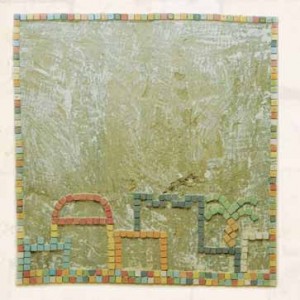 This tile creation was made by Sara Daniel from Alon Shevut. Daniel used small colorful square tiles to create the design, which is reminiscent of the mosaic floors that have been unearthed in archeological digs in Israel.
This tile creation was made by Sara Daniel from Alon Shevut. Daniel used small colorful square tiles to create the design, which is reminiscent of the mosaic floors that have been unearthed in archeological digs in Israel.
Photos: Yehoshua Halevi
Sources:
1. Shmuel Pinchas Gelbard, Rite and Reason: 1050 Jewish Customs and Their Sources (Jerusalem, 2000).
2. Moishe Dovid Lebovits, “Zecher L’Churban,” Halachically Speaking 3 (2007): 24.
3. Rabbi Ari Enkin, “Zecher L’Churban,” Hirhurim—Musings, July 14, 2009, http://torahmusings.com/2009/07/zecher-lchurban/.
Adina Hershberg, who made aliyah in 1981, has made aliyah twice to Har HaBayit. She prays that the next time she ascends Har HaBayit, the third and final Beit Hamikdash will be there in all of its glory.
Yehoshua Halevi has worked for more than twenty-five years as a professional photojournalist, teacher, mentor and photographer of lifecycle events. His credits include a distinguished list of international clientele, including major publications and magazines. His online portfolio is at www.goldenlightimages.com.
